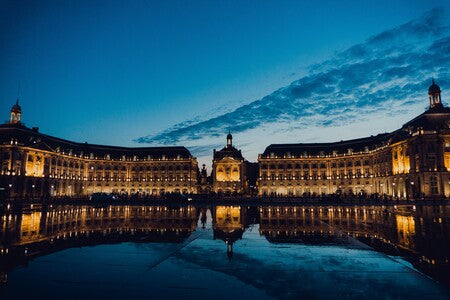
Let’s face it, Bordeaux can be an intimidating wine region. It’s prestigious and fetches high price tags. When people think of Bordeaux they think of the First Growths, the elite estates of, Lafite, Latour, Margaux, Haut Brion, and Mouton. While these command the market as the world’s most expensive wines, the majority of the wine produced in Bordeaux is actually labeled as generic Bordeaux AOC producing massive volumes of (mostly) reds and whites at entry level price points. So how do you sort through this major quality gap? As they say in real estate, “location, location, location.”
Bordeaux is located in southwest France, near the Atlantic Ocean. The Garonne and the Dordogne rivers merge to form the Gironde estuary. These three river systems form an upside down “Y” shape when looking at a map and divide Bordeaux into three winegrowing regions, each with their own individual character and style.
The vineyards to the west of the Garonne and Gironde form the Left Bank, and the vineyards to the east of the Dordogne and Gironde form the Right Bank. The vineyards in between are called Entre-Deux-Mers, literally translated to 'between two seas'.
The Left bank is known as the more prestigious area, home to the Frist Growths and blended from prominently Cabernet Sauvignon with high tannins, high acidity, and powerful structure. Bold aromas and flavors of black cherry, violet, and menthol are common. The top wines have aging potential for 30+ years.
In contrast, the Right bank wines are Merlot-dominate, rich in red fruits and herbaceous notes in cooler years. In warmer years, they offer flavors of stewed blackberry jam and baked plum. These wines have less tannins and acidity and are intended for an early-drinking style.
Several factors contribute to these stylistic differences, climate, soils, and winemaking techniques all contribute to quality.
The Left Bank sits closer to the ocean and the temperature is moderated by the Atlantic’s influence. Vineyards here get heavier rainfall with cooler temperatures during the growing season as a result.
The maritime influence is much less prominent in the Right Bank regions. The Right Bank is further inland, gets less rainfall and higher temperatures. It is also prone to frost which can drastically reduce yields like we saw in 2017 when the crop was decimated.
Soil differences are also important. The Left Bank is known for rocky, gravelly soils that offer ideal conditions for Cabernet Sauvignon to thrive. The gravel soils are well-draining, allowing roots to dry out so that grapes can fully ripen. The saying goes, vines don’t like wet feet. Vines should struggle for water as this encourages root and grape growth rather than just the leaves. The rocky soils also provide heat retention as the rocks hold warmth and gradually release it up towards the vines, creating slow and even ripening; allowing for long aging potential.
The best estates of the Right Bank are located in parts of Saint-Emilion and Pomerol. The soil here is mostly cool clay where Merlot ripens fully in almost every vintage. Since clay holds water, it allows Merlot to develop the big juicy berries it’s known for.
Understanding the basic stylistic differences between growing regions is helpful to determine what order on wine lists. Subtle differences in grape-growing and wine-making styles coupled with drastic vintage variation means you’ll find lots of varying quality levels. But, once you discover a beautiful Bordeaux with perfect balance between the elegant pronounced black fruit, rich charred wood, and savory earth, you’ll be chasing that wine the rest of your life!
Left Bank Wines to Try:
2018 Haut Selve Rouge $24.99 - VIEW PRODUCTS
This red is loaded with bright and lush red berry fruit. Velvety tannins with vanilla, smoke, and charred wood following on the long finish.
2016 Pavillon du Glana $26.99 - VIEW PRODUCTS
Full of personality! Aromas and flavors of savory smoke, black cherries, licorice, and vanilla. Full-bodied, silky tannins.
Right Bank Wines to Try:
2019 Château Bonalgue Pomerol $49.99 - VIEW PRODUCTS
Pronounced aromas of blueberry and black cherry. A hint of dried herbs and leather.
Elyse Genderson is the Vice President of Schneider’s. Visit her at the historic storefront (300 Mass Ave NE) to discover wines you’ll love.




